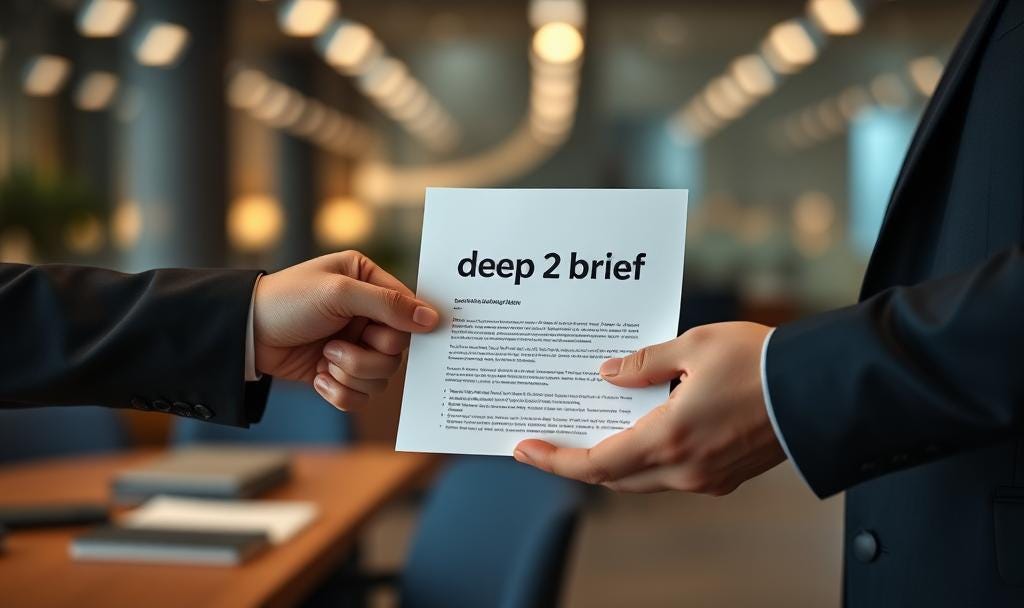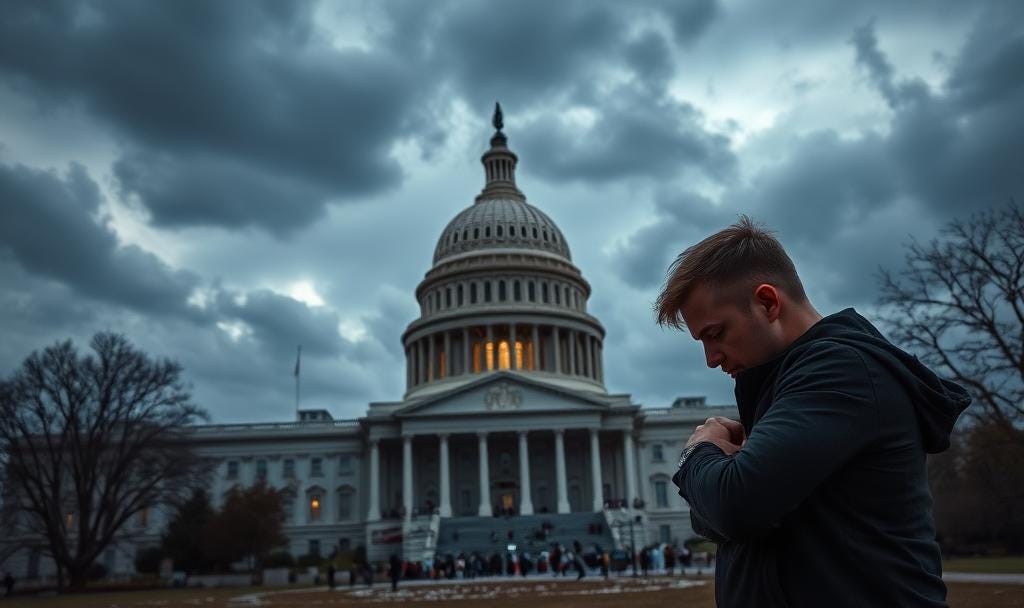From Deep Analysis to Congressional Action: Crafting Policy Memos That Get Results
Here, impact begins by reframing the problem from an Aging Congress to Building Congressional Capacity. Its a strategic shift that a House Subcommittee Chair might actually implement.
Editor's Note: Welcome to Q2 2025! As we enter the second quarter of this newsletter's life, I want to thank each of you for making the first three months of this newsletter a success. With 13 weekly posts and 31 subscribers, we're off to a promising start in exploring current events through a public policy lens. Looking ahead, I plan to alternate between deep analytical pieces and different formats like policy memos, op-eds, and case studies to show how policy research translates into practical outputs. I may sprinkle in surprises, like Tips and AMAs (Ask Me Anything posts - the modern equivalent to FAQs and Q&As). And I'm excited to introduce some premium content for paid subscribers this quarter, including exclusive discussion threads, expanded analysis, and access to the archive. Your support helps make this work possible, so I’m happy to answer questions and consider special requests for posts — yes, even if you’re a free member. Just hit reply if you’re reading this in your inbox, or hit the button below to send me a message.

In January, I published a four-part series examining the "aging Congress" phenomenon through a deep analysis using Kingdon's Multiple Streams Framework:
Dear Aging Congress, About your driving... (Problem Stream)
Solutions for Tackling Congress’s Age Challenge (Policy Stream)
Power, Politics, and Age: A Third Rail Legislators Won't Touch (Political Stream)
The Long Road to Congressional Reform (Coupling Process)
Today, I'm taking this analysis a step further by showing how research translates into practical recommendations. Below, you'll find a policy memo addressed to Rep. Stephanie Bice (R-OK), Chair of the House Subcommittee on Modernization and Innovation. This represents the type of document that might be prepared by a congressional staffer or policy advisor based on research like what I've shared in previous posts.
Note that this memo reframes the problem from “an aging Congress” to something Rep. Bice is more likely to support, both personally and as chair of this particular subcommittee.
After presenting the memo, I'll critique it to highlight both its strengths and areas for improvement. Rather than revising the memo myself, I'm leaving that exercise to you—an opportunity to apply the lessons from the critique to strengthen the recommendation.
Let's see how policy analysis becomes actionable advice.

Dark skies over congressional modernization: Will lawmakers adapt to changing expectations before public trust erodes further? (image source: Substack AI)Draft Policy Memo
To: Rep. Stephanie Bice (R-OK)
From: [Your Name], [Your Title]
Date: [Today's Date]
Subject: Restoring Public Trust in Congress Through Modernization and Innovation
Summary: Launch a bipartisan congressional modernization study focused on leadership development, ethics standards, and institutional knowledge transfer to address public trust concerns while avoiding controversial proposals like term limits.
Public frustration with Congress is reaching crisis levels. Many Americans perceive Congress as too old, out of touch, slow, and ineffective in the face of a rapidly changing political landscape. The thin partisan majorities, extreme polarization, and breakdown of civility make bipartisan collaboration nearly impossible. At the same time, President Trump’s direct and unilateral approach to governing—along with the DOGE efforts under Elon Musk—risk further marginalizing Congress, raising fundamental questions about its relevance. If these trends continue, the very justification for funding a dysfunctional legislature could come into question.
Recommendation: Launch a New Bipartisan Study to Build Congressional Capacity
As Chair of the House Subcommittee on Modernization and Innovation, you have a critical opportunity to lead a pragmatic, bipartisan effort to revitalize Congressional effectiveness and restore public trust. I recommend commissioning a study that builds on the success of the Select Committee on the Modernization of Congress, that lead to the adoption of 202 bipartisan recommendations during the 116th and 117th Congresses, and began implementing them under your leadership in the 118th Congress.
The Committee's new study should focus on:
Building Leadership Capacity – Developing structured pathways for junior members to advance their leadership skills while creating advisory roles for senior members who wish to transition from full leadership duties.
Strengthening Ethics and Accountability – Ensuring attendance and voting transparency to reinforce public expectations that members fulfill their basic responsibilities no matter what their age or health situation.
Supporting Knowledge Transfer & Continuity – Implement formal succession planning and best practices to retain institutional expertise during absences and role transitions.
This study would proactively address public concerns while avoiding politically divisive measures such as term or age limits. By championing such modernization and innovation goals, you can position yourself as a leader in strengthening Congressional effectiveness and public trust.
Alternative Approaches and Their Tradeoffs
Term Limits
Pros - Encourages turnover, fresh perspectives
Cons- Requires constitutional amendment, weakens institutional memoryAge Limits
Pros - Directly addresses concerns about aging lawmakers
Cons - Oversimplifies the issue, risks alienating effective senior membersMandatory Health Assessments
Pros - Offers objective capacity measures
Cons - Legally and politically sensitive, potential for misuseStronger Attendance Standards
Pros - Reinforces public accountability
Cons - Could be perceived as targeting individuals rather than improving CongressDo Nothing
Pros - Avoids controversy, maintains status quo
Cons - Fails to address public concerns, risks further erosion of Congressional authority
Political Considerations
Strategic Positioning – This initiative aligns with bipartisan modernization efforts, ensuring Congress remains a strong institution regardless of party leadership.
Messaging to Senior Members – This effort strengthens, rather than sidelines, experienced legislators by valuing institutional expertise while fostering new leadership and generational change.
Bipartisan Support & Partnerships – Organizations like the POPVOX Foundation and FutureCongress.org could serve as key partners in advancing this discussion beyond partisan divides.
Conclusion
Congress faces real and pressing challenges to its effectiveness. Rather than allowing continued decline or reacting with blunt solutions like term limits, a targeted modernization study offers a pragmatic, achievable path forward. Your leadership on this issue would demonstrate proactive governance, reinforce public confidence, and ensure Congress remains a strong institution for generations to come.
I would be happy to provide additional research or insights to support this initiative. Thank you for your attention to this critical matter.

Critique: Strengths and Areas for Improvement
Not a bad draft, but this policy memo could be improved to make it even more impactful. Let’s review its strengths first, then consider how it can be improved.
What Worked Well
Concise Executive Summary: You present your core recommendation in just 1-3 sentences, right at the top. This allows an extremely busy decision maker to immediately grasp your advice, even if they only have seconds to scan the document.
Strong Opening Context: You immediately establish urgency by describing congressional dysfunction and public frustration. This builds a compelling case for action, like a doctor explaining why a patient needs treatment before proposing a solution.
Clear Recommendation Structure: The memo follows a logical flow from problem identification to concrete recommendations, making it easy for a busy representative to grasp your proposal quickly.
Politically Savvy Positioning: Your approach thoughtfully acknowledges the representative's role as Subcommittee Chair and builds on existing successful initiatives, making the proposal more credible and actionable.
Keep reading with a 7-day free trial
Subscribe to Views Through a Policy Prism to keep reading this post and get 7 days of free access to the full post archives.



